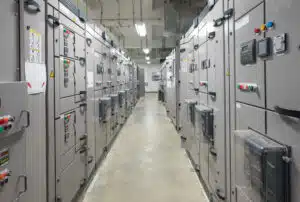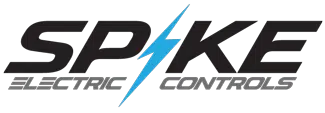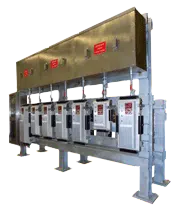The Difference Between SwitchGear And SwitchBoard
 The switchboard and switchgear are both critical components of any electrical system. However, there is a lot of confusion about the two terms in the electrical industry. A closer look at their functions, physical design and testing standards reveals dissimilarities between the two.
The switchboard and switchgear are both critical components of any electrical system. However, there is a lot of confusion about the two terms in the electrical industry. A closer look at their functions, physical design and testing standards reveals dissimilarities between the two.
Switchboards and Switchgear have different functions as well as capabilities. Whether you would want to use switchgear or switchboard will largely depend on the requirement of the power systems. For a better understanding, let us differentiate between the two based on their functions and other parameters.
What is Switchgear?
Switchgear is a term that describes a collection of switching devices that serve to control, protect and isolate power systems. Also, the definition will extend to circuit breakers and devices that meter a power system. During power breakdowns, switchgear will trigger an automatic reaction and interrupt the power flow. This is turn would protect the electrical circuits from damage.
What Are The Main Components Of Switchgear?
Switchgear consists of switches, fuses, isolators, relays, lightning arresters, potential transformers, auto reclosures and other components.
It also consists of drawout casset circuit breakers and other devices for protection, metering, and control regulation.
Switchgear Voltages can Range from 480V Low Voltage thru 350kV Medium Votlage
What Are SwitchBoards?
A switchboard is a single large panel, frame, assembly of switches, fix mount circuit breakers, overcurrent and other protective devices. Field technicians can access these assemblies from the rear as well as from the front. Switchboards are similar to panelboards and normally come with 600V of power and are usually 1600Amps and higher. Panelboards are typically 1200Amps and lower.
What Are The Main Components Of A Switchboard?
A switchboard consists of a single vertical structure that contains the main disconnects and surge protection.
It also consists of frequency gauges and synchroscopes that can control devices through multiple power sources.
It also includes busbars to distribute incoming power from the source to other destination points.
Major Differences Between Switchgear And Switchboards
There are some major differences between switchgear and switchboards that a contractor must understand before proceeding with his job.
| Criteria | Switchgear | Switchboards |
| Voltage |
Switchgear is designed to handle higher voltages that can reach 350 kV. |
Switchboards are designed to handle lower voltages that are generally less than 600 volts. |
| Safety Features |
Switchgears come with automatic features and come with manual control during emergency. |
Switchboards don’t have any automatic features and are placed to display the amount of power consumed by individual circuits. |
| Difference in Hardware |
Switchgear has switching devices that are required for low to medium-voltage circuits. |
Switchboards consist of panels where switches, buses, and electrical control devices have been mounted on the front or back end. |
| Difference in Use |
Switchgears find their use in powering transformers, motors, transmission lines, generators, and power networks. Plus, they are mainly used for industrial setups. |
Switchboards are only used to distribute power to multiple sources and transmit them to individual loads, transformers, panel boards and control equipment. |
| Price |
Switchgears are more expensive than switchboards due to their complex setup. |
Switchboards are comparatively less expensive than switchgear. Individually mounted switchboards are costlier than group mounted ones. |
| Circuit Breakers |
Switchgear breakers are typically withdrawable units. |
Switchboard typically have fixed mount circuit breakers that are connected directly to bus bar |
These are the basic differences between switchgear and switchboards. If you wish to know more, please contact our team for more information.
Why Spike Electric?
We are a nationally-recognized Switchgear manufacturer of quality electrical equipment. Our number one goal is to minimize risks and prioritize the safety of our clients at job sites. Besides, we reduce the risk of quality issues with our 100% dedicated ISO 9001 management team.
We operate with an expert team of engineers who are some of the best in the industry in designing custom electrical equipment to fit your needs. If you have any trouble with obsolete Switchgear, please call us 24/7 for the quickest support in North America.
Written by: Cole Attaway
Cole Attaway is the founder and CEO of Spike Electric Controls. Spike's mission is to improve the accessibility and delivery of industrial electrical gear for clients nationwide. Spike solutions result in reduced unplanned downtime, less overtime, and greater operational efficiencies.


